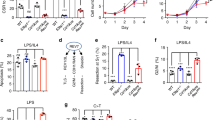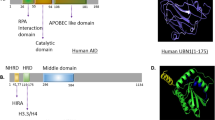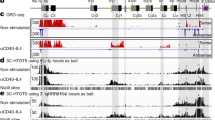Abstract
Activation-induced cytidine deaminase (AID), which is specific to B lymphocytes, is required for class switch recombination (CSR)—a process mediating isotype switching of immunoglobulin—and somatic hypermutation—the introduction of many point mutations into the immunoglobulin variable region genes1,2. It has been suggested that AID may function as an RNA-editing enzyme3 or as a cytidine deaminase on DNA4,5. However, the precise enzymatic activity of AID has not been assessed in previous studies. Similarly, although transcription of the target immunoglobulin locus sequences is required for both CSR and somatic hypermutation, the precise role of transcription has remained speculative6,7,8,9. Here we use two different assays to demonstrate that AID can deaminate specifically cytidines on single-stranded (ss)DNA but not double-stranded (ds)DNA substrates in vitro. However, dsDNA can be deaminated by AID in vitro when the reaction is coupled to transcription. Moreover, a synthetic dsDNA sequence, which targets CSR in vivo in a manner dependent on transcriptional orientation10, was deaminated by AID in vitro with the same transcriptional-orientation-dependence as observed for endogenous CSR. We conclude that transcription targets the DNA deamination activity of AID to dsDNA by generating secondary structures that provide ssDNA substrates.
This is a preview of subscription content, access via your institution
Access options
Subscribe to this journal
Receive 51 print issues and online access
$199.00 per year
only $3.90 per issue
Buy this article
- Purchase on Springer Link
- Instant access to full article PDF
Prices may be subject to local taxes which are calculated during checkout




Similar content being viewed by others
References
Muramatsu, M. et al. Class switch recombination and hypermutation require activation-induced cytidine deaminase (AID), a potential RNA editing enzyme. Cell 102, 553–563 (2000)
Revy, P. et al. Activation-induced cytidine deaminase (AID) deficiency causes the autosomal recessive form of the Hyper-IgM syndrome (HIGM2). Cell 102, 565–575 (2000)
Doi, T., Kinoshita, K., Ikegawa, M., Muramatsu, M. & Honjo, T. De novo protein synthesis is required for the activation-induced cytidine deaminase function in class-switch recombination. Proc. Natl Acad. Sci. USA 18, 2634–2638 (2003)
Petersen-Mahrt, S. K., Harris, R. S. & Neuberger, M. S. AID mutates E. coli suggesting a DNA deamination mechanism for antibody diversification. Nature 418, 99–103 (2002)
Rada, C. et al. Immunoglobulin isotype switching is inhibited and somatic hypermutation perturbed in UNG-deficient mice. Curr. Biol. 12, 1748–1755 (2002)
Manis, J. P., Tian, M. & Alt, F. W. Mechanism and control of class-switch recombination. Trends Immunol. 23, 31–39 (2002)
Honjo, T., Kinoshita, K. & Muramatsu, M. Molecular mechanism of class switch recombination: linkage with somatic hypermutation. Annu. Rev. Immunol. 20, 165–196 (2002)
Martin, A. & Scharff, M. D. AID and mismatch repair in antibody diversification. Nature Rev. Immunol. 2, 605–614 (2002)
Papavasiliou, F. N. & Schatz, D. G. Somatic hypermutation of immunoglobulin genes: merging mechanisms for genetic diversity. Cell 109 (suppl.), 35–44 (2002)
Shinkura, R. et al. The effect of transcriptional orientation on endogenous switch region function. Nature Immunol. (in the press)
Bassing, C. H., Swat, W. & Alt, F. W. The mechanism and regulation of chromosomal V(D)J recombination. Cell 109 (suppl.), 45–55 (2002)
Luby, T. M., Schrader, C. E., Stavnezer, J. & Selsing, E. The mu switch region tandem repeats are important, but not required, for antibody class switch recombination. J. Exp. Med. 193, 159–168 (2001)
Stavnezer, J. Molecular processes that regulate class switching. Curr. Top. Microbiol. Immunol. 245, 127–168 (2000)
Martin, A. et al. Activation-induced cytidine deaminase turns on somatic hypermutation in hybridomas. Nature 415, 802–806 (2002)
Yoshikawa, K. et al. AID enzyme-induced hypermutation in an actively transcribed gene in fibroblasts. Science 296, 2033–2036 (2002)
Di Noia, J. & Neuberger, M. S. Altering the pathway of immunoglobulin hypermutation by inhibiting uracil-DNA glycosylase. Nature 419, 43–48 (2002)
Papavasiliou, F. N. & Schatz, D. G. The activation-induced deaminase functions in a postcleavage step of the somatic hypermutation process. J. Exp. Med. 195, 1193–1198 (2002)
Muramatsu, M. et al. Specific expression of activation-induced cytidine deaminase (AID), a novel member of the RNA-editing deaminase family in germinal center B cells. J. Biol. Chem. 274, 18470–18476 (1999)
Reaban, M. E. & Griffin, J. A. Induction of RNA-stabilized DNA conformers by transcription of an immunoglobulin switch region. Nature 348, 342–344 (1990)
Daniels, G. A. & Lieber, M. R. RNA:DNA complex formation upon transcription of immunoglobulin switch regions: implications for the mechanism and regulation of class switch recombination. Nucleic Acids Res. 23, 5006–5011 (1995)
Tian, M. & Alt, F. W. Transcription-induced cleavage of immunoglobulin switch regions by nucleotide excision repair nucleases in vitro. J. Biol. Chem. 275, 24163–24172 (2000)
Mizuta, R. et al. Molecular visualization of immunoglobulin switch region RNA/DNA complex by atomic force microscope. J. Biol. Chem. 278, 4431–4434 (2003)
Tashiro, J., Kinoshita, K. & Honjo, T. Palindromic but not G-rich sequences are targets of class switch recombination. Int. Immunol. 13, 495–505 (2001)
Dunnick, W., Hertz, G. Z., Scappino, L. & Gritzmacher, C. DNA sequences at immunoglobulin switch region recombination sites. Nucleic Acids Res. 21, 365–372 (1993)
Shanmugam, A., Shi, M. J., Yauch, L., Stavnezer, J. & Kenter, A. L. Evidence for class-specific factors in immunoglobulin isotype switching. J. Exp. Med. 191, 1365–1380 (2000)
Faili, A. et al. AID-dependent somatic hypermutation occurs as a DNA single-strand event in the BL2 cell line. Nature Immunol. 3, 815–821 (2002)
Artsimovitch, I. & Landick, R. The transcriptional regulator RfaH stimulates RNA chain synthesis after recruitment to elongation complexes by the exposed nontemplate DNA strand. Cell 109, 193–203 (2002)
Storb, U. et al. Cis-acting sequences that affect somatic hypermutation of Ig genes. Immunol. Rev. 162, 153–160 (1998)
Yu, K., Chedin, F., Hsieh, C. L., Wilson, T. E. & Lieber, M. R. R-loops at immunoglobulin class switch regions within the chromosomes of stimulated B cells. Nature Immunol. (in the press)
Sartori, A. A., Schar, P., Fitz-Gibbon, S., Miller, J. H. & Jiricny, J. Biochemical characterization of uracil processing activities in the hyperthermophilic archaeon Pyrobaculum aerophilum. J. Biol. Chem. 276, 29979–29986 (2001)
Ramiro, A. R., Stavropoulos, P., Jankovic, M. & Nussenzweig, M. C. Transcription enhances AID-mediated cytidine deamination by exposing ssDNA on the nontemplate strand. Nature Immunol. (in the press)
Acknowledgements
We thank T. Honjo for providing AID-deficient mice and B. Demple for helpful discussions. We also thank J. Manis, A. Zarrin, S. Ranganath and S. Saleque for suggestions and critical reading of the manuscript. This work was supported by a NIH grant (F.W.A.) and a NIH training grant (M.T.). K.C. is supported by a Pfizer Postdoctoral Fellowship in Rheumatology/Immunology and E.P. is supported by a Fondation pour la Recherche Medicale Postdoctoral Fellowship. F.W.A. is an Investigator and J.C. an Associate of the Howard Hughes Medical Institute.
Author information
Authors and Affiliations
Corresponding author
Ethics declarations
Competing interests
The authors declare that they have no competing financial interests.
Rights and permissions
About this article
Cite this article
Chaudhuri, J., Tian, M., Khuong, C. et al. Transcription-targeted DNA deamination by the AID antibody diversification enzyme. Nature 422, 726–730 (2003). https://doi.org/10.1038/nature01574
Received:
Accepted:
Published:
Issue Date:
DOI: https://doi.org/10.1038/nature01574
This article is cited by
-
Cas9 variants expand the targeting scope of base editing systems in bacteria
The Nucleus (2024)
-
Compact zinc finger base editors that edit mitochondrial or nuclear DNA in vitro and in vivo
Nature Communications (2022)
-
Single-stranded DNA binding proteins influence APOBEC3A substrate preference
Scientific Reports (2021)
-
Polymerase-guided base editing enables in vivo mutagenesis and rapid protein engineering
Nature Communications (2021)
-
Regulatory R-loops as facilitators of gene expression and genome stability
Nature Reviews Molecular Cell Biology (2020)
Comments
By submitting a comment you agree to abide by our Terms and Community Guidelines. If you find something abusive or that does not comply with our terms or guidelines please flag it as inappropriate.



